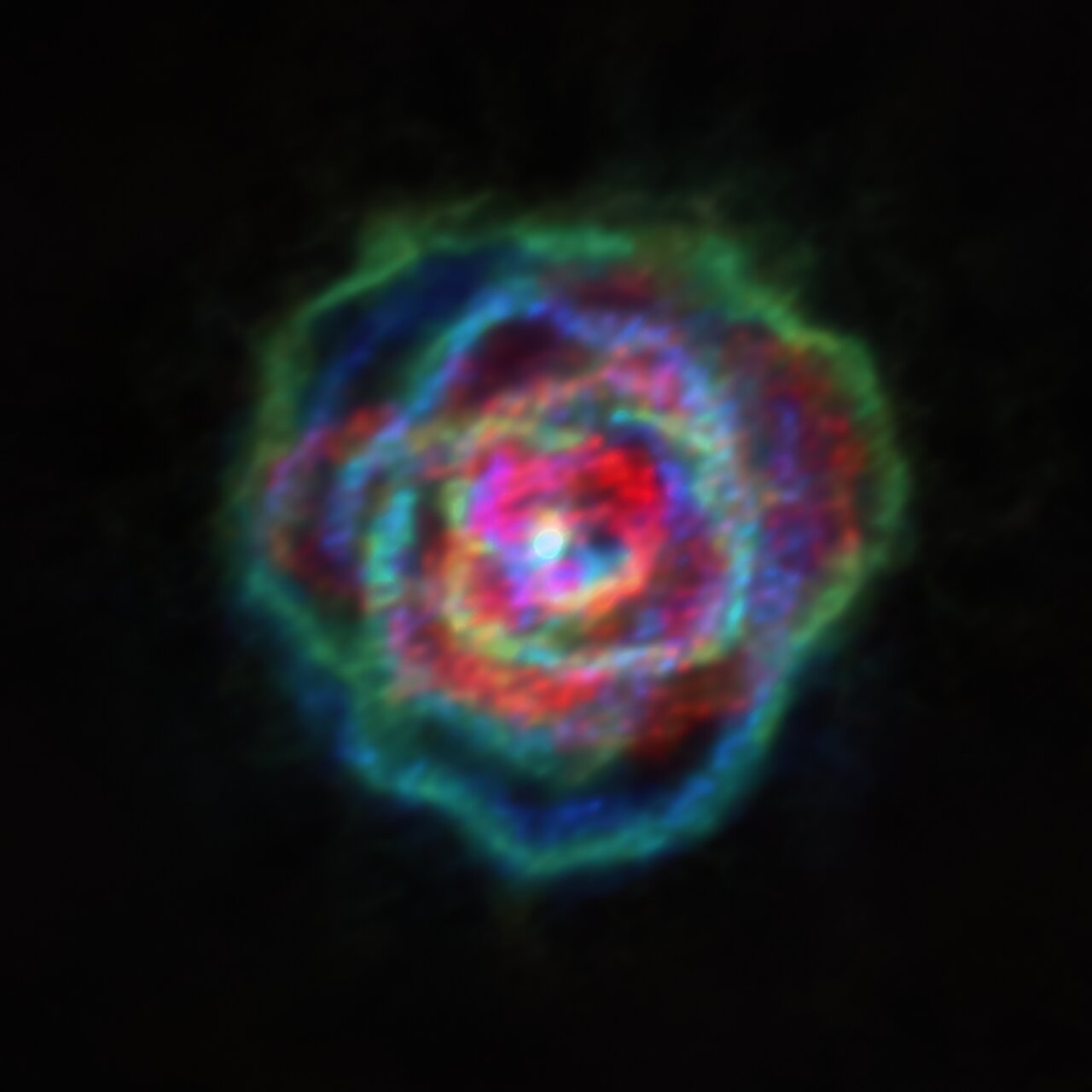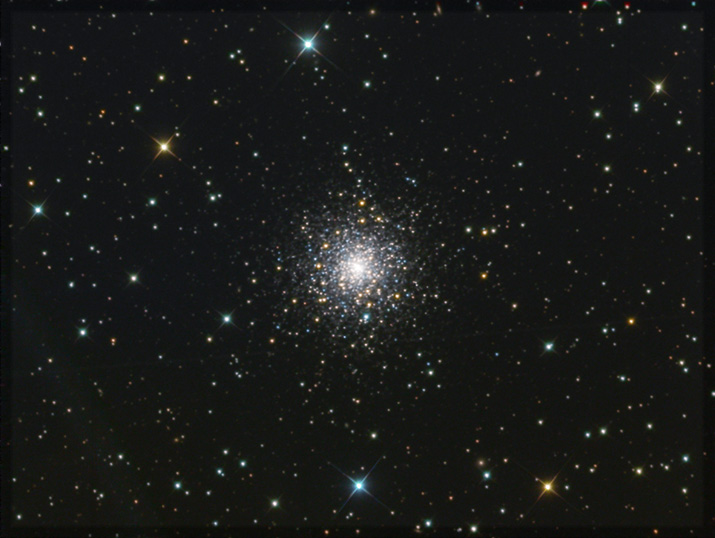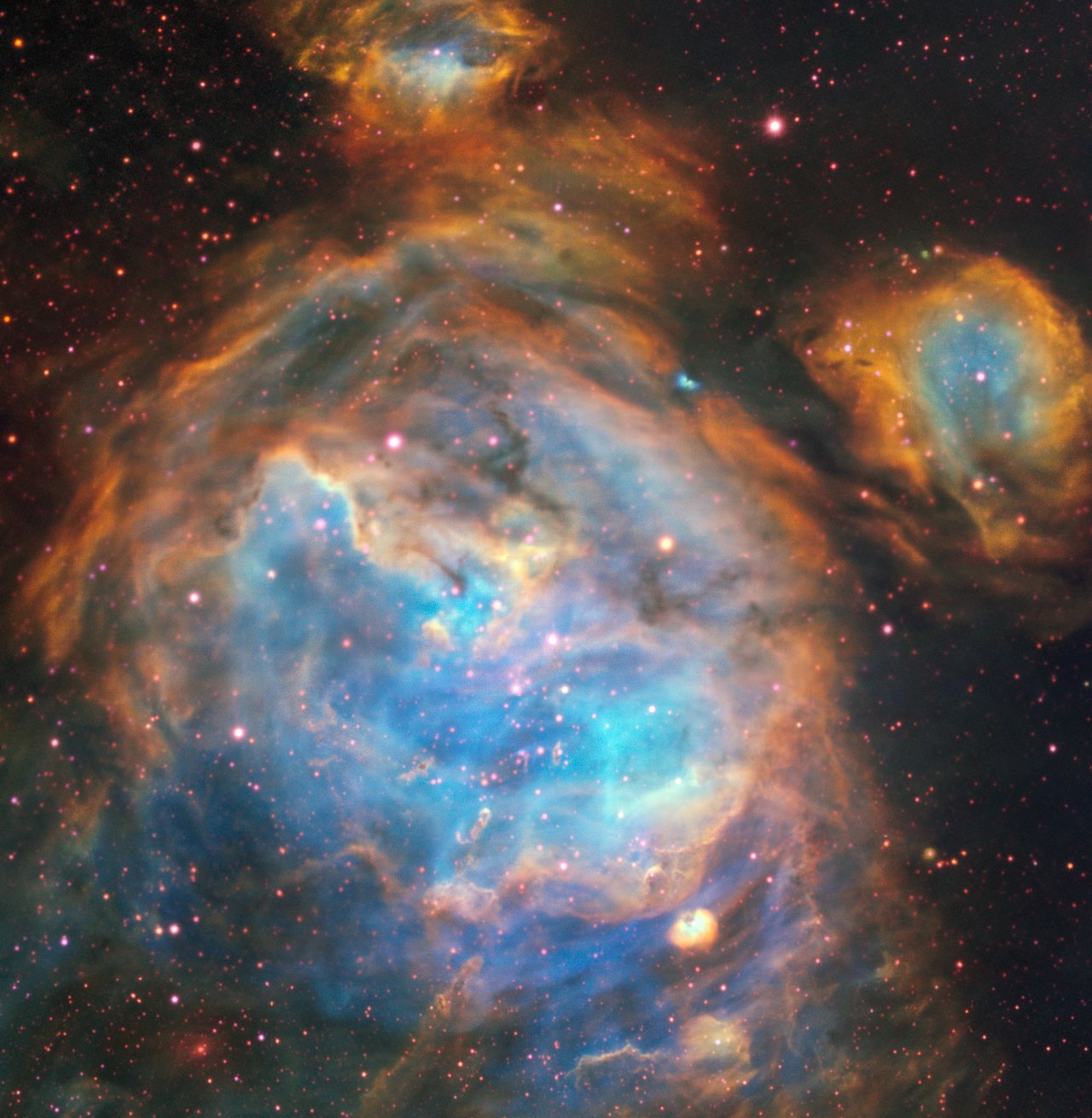Page 2 of 3
HEIC: Eye of the Serpent (NGC 2835)
Posted: Mon Sep 14, 2020 3:40 pm
by bystander
Eye of the Serpent
ESA Hubble Picture of the Week | 2020 Sep 14
The twisting patterns created by the multiple spiral arms of
NGC 2835 create the illusion of an eye. This is a fitting description, as this magnificent galaxy resides near the head of the southern constellation of
Hydra,
the water snake. This stunning
barred spiral galaxy, with a width of just over half that of the Milky Way, is brilliantly featured in this image taken by the NASA/ESA
Hubble Space Telescope. Although it cannot be seen in this image, a
supermassive black hole with a mass millions of times that of our Sun is known to nestle in the very centre of
NGC 2835.
This galaxy was imaged as part of
PHANGS-HST, a large galaxy survey with Hubble that aims to study the connections between cold gas and young stars in a variety of galaxies in the local Universe. Within NGC 2835, this cold, dense gas produces large numbers of young stars within large
star formation regions. The bright blue areas, commonly observed in the outer spiral arms of many galaxies, show where near-
ultraviolet light is being emitted more strongly , indicating recent or ongoing star formation.
Expected to image over 100,000 gas clouds and star-forming regions outside our Milky Way, this survey hopes to uncover and clarify many of the links between cold gas clouds, star formation and the overall shape and morphology of galaxies. This initiative is a collaboration with the international Atacama Large Millimeter/submillimeter Array (
ALMA) and the European Southern Observatory's Very Large Telescope's
MUSE instrument, through the greater
PHANGS program (PI: E. Schinnerer).
Re: Found Images: 2020 September
Posted: Tue Sep 15, 2020 6:12 am
by Ann
The Iris Nebula
https://remarkableheavens.com/?page_id=359
Copyright: Greenturtlelab
Re: Found Images: 2020 September
Posted: Tue Sep 15, 2020 6:48 am
by Ann
NGC 5139, Centaurus A
https://remarkableheavens.com/?page_id=359
Copyright: Greenturtlelab
Re: Found Images: 2020 September
Posted: Tue Sep 15, 2020 8:05 am
by starsurfer
Re: Found Images: 2020 September
Posted: Tue Sep 15, 2020 8:07 am
by starsurfer
Sh2-174
http://www.cfm2004.altervista.org/astro ... 2-174.html
Copyright: Cristina Cellini and Fiorenzo Mazzotti
Re: Found Images: 2020 September
Posted: Tue Sep 15, 2020 8:09 am
by starsurfer
Sh2-221, Sh2-216 and C/2017 T2 Panstarrs
https://www.astrobin.com/s8usj9/
Copyright: Peter Csordas
Re: Found Images: 2020 September
Posted: Tue Sep 15, 2020 8:10 am
by starsurfer
CG 4
https://www.astrobin.com/z8pu0a/
Copyright: Xing Keyu/Chilescope
AAS: Simulating the Birth of a Close Binary
Posted: Thu Sep 17, 2020 4:20 pm
by bystander
Simulating the Birth of a Close Binary
AAS NOVA | Featured Image | 2020 Sep 14
The stills above (click for the full view!) represent different time stages in the formation of a close stellar binary from a collapsing cloud of gas. In a recent study, two researchers from Kyushu University in Japan, Yu Saiki and Masahiro Machida, conduct numerical simulations to track the complicated process of a binary’s formation and evolution over ~400 years. In the above frames, the top left panel shows the fragmentation of the gas cloud into two cores roughly 9,000 years after the cloud initially begins to collapse. The succeeding panels show how the separation between these two protostars shrinks over the next several hundred years and disks of gas form around each star and around the binary pair. Saiki and Machida’s simulations also show the high-velocity jets driven from each protostar in the process (see the
video below), and how the twin jets tangle on large scales as the stars orbit one another. The characteristics revealed in these simulations neatly reproduce our observations of protobinary systems. For more information, check out the original article linked below the video.
Twin Jets and Close Binary Formation ~ Yu Saiki, Masahiro N. Machida
ESO: Flowers of Stellar Wind (R Aquilae)
Posted: Mon Sep 21, 2020 2:43 pm
by bystander
Flowers of Stellar Wind Could
Be Due to Stellar Companions
ESO Picture of the Week | 2020 Feb 21
The ongoing large-scale
ATOMIUM project is being conducted in collaboration with
ALMA, the Atacama Large Millimeter/submillimeter Array, which is located in Chile and has ESO as a partner. The project set out to map the stellar winds blowing out from around a dozen
red giant stars, an ambitious goal made possible thanks to ALMA’s spectacular resolution. These
stellar winds — which are sometimes millions of times stronger than those of our Sun — were expected to be spherical, like the parent stars that they are blasted away from.
However, researchers did not observe spherical stellar winds, but something quite different. As seen in the above image — which shows winds around a star called
R Aquilae — the team found that in all cases the stellar winds were not spherical, but had different shapes, including some resembling the delicate petals of a rose. The patterns seen in the stellar winds have a striking resemblance to those of
planetary nebulae.
The research team, led by Leen Decin at
KULeuven, Belgium, proposed that a process known as binary interaction is responsible for the shape of the stellar winds of red giant stars. As the name suggests, binary interaction involves two objects. The theory is that the stellar winds achieve their shape due to the influence of another star, or a giant planet. Stellar winds are the precursors to planetary nebulae, and the apparent similarity in their structures indicates that the physics that shapes stellar winds also shapes planetary nebulae, and hence that binary interaction is the key agent carving out the planetary nebulae morphologies.
viewtopic.php?t=41017
HEIC: Dark Matter Surplus (NGC 5585)
Posted: Mon Sep 21, 2020 2:57 pm
by bystander
Dark Matter Surplus
ESA Hubble Picture of the Week | 2020 Sep 21
Credit: ESA/Hubble & NASA, R. Tully
Acknowledgement: Gagandeep Anand
Resting on the tail of the
Great Bear in the constellation of
Ursa Major, lies NGC 5585, a
spiral galaxy that is more than it appears.
The many stars, and dust and gas clouds that make up
NGC 5585, shown here in this Hubble image, contribute only a small fraction of the total mass of the galaxy. As in many galaxies, this discrepancy can be explained by the abundant yet seemingly invisible presence of
dark matter.
The stellar disc of the galaxy extends over 35 000
light-years across. When compared with galaxies of a similar shape and size,
NGC 5585 stands out by having a notably different composition: Contributing to the total mass of the galaxy, it contains a far higher proportion of dark matter.
Hotspots of star formation can be seen along the galaxy’s faint spiral arms. These regions shine a brilliant blue, contrasting strikingly against the ever-black background of space.
Re: Found Images: 2020 September
Posted: Tue Sep 22, 2020 11:18 am
by starsurfer
NGC 7773
https://www.spacetelescope.org/images/potw1922a/
Copyright: ESA/Hubble & NASA, J. Walsh
Re: Found Images: 2020 September
Posted: Tue Sep 22, 2020 11:20 am
by starsurfer
Re: Found Images: 2020 September
Posted: Tue Sep 22, 2020 11:23 am
by starsurfer
Ou 4
http://www.capella-observatory.com/Imag ... rnPart.htm
Copyright: Makis Palaiologou, Stefan Binnewies and Josef Pöpsel
This image shows the southern lobe of Ou 4.
Re: Found Images: 2020 September
Posted: Wed Sep 23, 2020 1:16 pm
by starsurfer
NGC 6914
https://www.astrobin.com/7o8ku0/
Copyright: Robert Novotný
Re: Found Images: 2020 September
Posted: Wed Sep 23, 2020 1:18 pm
by starsurfer
NGC 6992
https://www.astrobin.com/9n7ez9/
Copyright: Sergiy Vakulenko
Re: Found Images: 2020 September
Posted: Wed Sep 23, 2020 1:19 pm
by starsurfer
Re: Found Images: 2020 September
Posted: Wed Sep 23, 2020 1:20 pm
by starsurfer
ESO: Encircling Antu (VLT)
Posted: Mon Sep 28, 2020 2:49 pm
by bystander
Encircling Antu
ESO Picture of the Week | 2020 Sep 28
Despite its name, ESO’s Very Large Telescope, the
VLT, is not a single telescope! It is in fact made up of an array of four 8.2-metre-diameter Unit Telescopes (
UTs) (one of which is shown here) and four additional, movable, 1.8-metre-diameter Auxiliary Telescopes (
ATs) (three of which are visible on the right side of this image).
Each UT has its own individual name in the region’s native Mapuche (
Mapudungun) language. The star of this image is
Antu (or UT1, the first of the UTs), and is pictured here sitting atop Cerro Paranal in Chile. This polychromatic image, taken by ESO Photo Ambassador
Petr Horálek, also captures the beautiful colours of the cloudy night sky encircling Antu.
Many night-sky objects are visible here. Starting from the left we see the pink
California Nebula, the
Pleiades star cluster, the fiery river of the Milky Way, the constellation of
Orion and its famous Belt, the looping
Gum Nebula, the
Carina Nebula and the
Southern Cross.
The most curious features are the green bands or stripes to the right of Antu’s enclosure. They are atmospheric
gravity waves, generated by storms forming ripples in the greenish layer of Earth’s
airglow in the upper atmosphere. This image also appeared in an ESOcast dedicated to
Red Sprites, which can occur under similar conditions as gravity waves.
HEAPOW: Spirals Are In This Season (NGC 5643)
Posted: Mon Sep 28, 2020 3:04 pm
by bystander
Spirals Are In This Season
ESA Hubble Picture of the Week | 2020 Sep 28
This stunning image by the NASA/ESA Hubble Space Telescope features the spiral galaxy
NGC 5643 in the constellation of
Lupus (
The Wolf). Looking this good isn’t easy; thirty different exposures, for a total of 9 hours observation time, together with the high resolution and clarity of Hubble, were needed to produce an image of such high level of detail and of beauty.
NGC 5643 is about 60 million light-years away from Earth and has been the host of a recent supernova event (not visible in this latest image). This supernova (
2017cbv) was a specific type in which a white dwarf steals so much mass from a companion star that it becomes unstable and explodes. The explosion releases significant amounts of energy and lights up that part of the galaxy.
The observation was proposed by
Adam Riess, who was awarded a Nobel Laureate in physics 2011 for his contributions to the discovery of the accelerating expansion of the Universe, alongside Saul Perlmutter and Brian Schmidt.
Re: Found Images: 2020 September
Posted: Mon Sep 28, 2020 4:17 pm
by purplepeakadventures
The Milky Way arches over the abandoned church in Dunlewy, Co. Donegal, Ireland during an exceptionally clear night sky in late September 2020. This is a composite of 46 individual frames of the night sky and one single image image for the church. A 35mm lens was used for the night sky frames with a 1 minute exposure at F2.0 and ISO 800. The astrotracer function on the Pentax K1 rotates the camera sensor to compensate for the Earth's rotation; without the astrotracer other cameras would only allow for an exposure of up to 15 seconds before the stars become blurred by the Earth's rotation.
The final mosaic of the 46 frames is about 30,728 by 21,189 pixels in dimensions; equivalent to a single 651 million pixel image!

AAS: Blob Ejection May Cause Magnetar Bursts
Posted: Tue Sep 29, 2020 8:26 pm
by bystander
Blob Ejection May Cause Magnetar Bursts
AAS NOVA | Featured Image | 2020 Sep 28
Susanna Kohler wrote:
How could a magnetar — a powerfully magnetized neutron star — produce the brief flashes of radio emission and X-rays we’ve recently spotted from SGR 1935+2154, the first equivalent of a fast radio burst in our own galaxy? Magnetars have crusts that can suddenly crack and shear, shaking the magnetic fields of the star in what’s known as a magnetar quake. Using numerical simulations, a team of scientists led by Yajie Yuan (CCA, Flatiron Institute) has shown that waves from a magnetar quake can propagate to the star’s magnetosphere, converting into blobs of magnetized plasma. These plasmoids accelerate outward from the star, driving blast waves into the surrounding magnetar wind that generate simultaneous X-ray and radio bursts. ...
Plasmoid Ejection by Alfvén Waves and the Fast Radio Bursts from SGR 1935+2154 ~ Yajie Yuan
et al
Fast Radio Bursts from Magnetars
Max Planck Institute for Astrophysics | 2020 Sep 01
viewtopic.php?p=306168#p306168
viewtopic.php?p=302683#p302683
Re: Found Images: 2020 September
Posted: Wed Sep 30, 2020 1:21 pm
by starsurfer
Re: Found Images: 2020 September
Posted: Wed Sep 30, 2020 1:24 pm
by starsurfer
Re: Found Images: 2020 September
Posted: Wed Sep 30, 2020 1:26 pm
by starsurfer
IC 5152
http://www.chart32.de/index.php/component/k2/item/365
Copyright: CHART32
Processing: Bernd Flach-Wilken
Re: Found Images: 2020 September
Posted: Wed Sep 30, 2020 1:28 pm
by starsurfer












